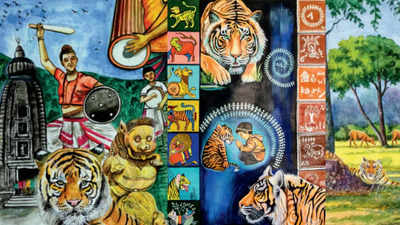- News
- City News
- delhi News
- Inspiration for creativity and art through eye of the tiger
Trending
Inspiration for creativity and art through eye of the tiger
Tribal artists from tiger reserve areas are participating in Delhi's 'Artists-In-Residence' programme at Rashtrapati Bhawan to create artworks reflecting their coexistence with tigers. Supported by various organizations, the initiative promotes conservation and showcases cultural stories while benefiting the artists financially through sales at an exhibition.

Silent conversations
To build on the message of conservation, 15 tribal artists, including 12 living within the ecosystem of tiger reserves, will be joining the prestigious 'Artists-In-Residence' programme at the Rashtrapati Bhawan, starting Monday, where they will create artworks to tell the story of co-existence. Their creations will be presented to President Droupadi Murmu on Oct 29.

These artists have come from areas in and around the Jim Corbett National Park in Uttarakhand, the Kanha and Satpura in Madhya Pradesh, the Nawegaon Nagzira and Melghat in Maharashtra, the Indravati National Park in Chhattisgarh, Similipal in Odisha, the Kawal Tiger Reserve in Telangana, and Dampa in Mizoram.

These 15 artists have been drawn from among 49, including tribals and other forest dwellers, whose artworks were showcased at an exhibition at the India Habitat Centre from Oct 17- 20. They brought forth stories of what the tiger symbolizes in tribal folklore, traditions, and culture. The exhibition "Silent Conversation: From Margins to the Centre" was organised by the
National Tiger Conservation Authority and non-profit Sankala Foundation that works on sustainable development. It was supported by the National Human Rights Commission (NHRC) and the International Big Cat Alliance.

Stories of interface of humans and nature were spread over canvases of 200 paintings and 100 art pieces of artists who live in and around 22 tiger reserves spread across states like Madhya Pradesh, Uttarakhand, Rajashtan, Maharashtra, Chhattisgarh, Jharkhand, Odisha, Telangana, Arunachal Pradesh, and Mizoram.

A striking painting by Gujral Singh Baghel from the Indravati Tiger Reserve depicts the culture of the Abujhmadia tribal community. It celebrates the relationship between the tiger and local hero "Tiger Boy Chendru", known for his courage. In another soft portrayal, artist Arachand Soren from the Similipal Tiger Reserve shows a tigress named Khairi playing with humans. Artist Minakshi Khati from the Jim Corbett Tiger Reserve area pays tribute to the tiger of Kumaon in colourful Aipan motifs to bring out its features of strength.
These artists will be part of the 'Artists-In-Residence' programme. According to Sankala Foundation by Sunday evening over 100 paintings in the exhibition were sold and many more reserved by buyers, including not just connaisseurs of art, but also embassies and govt offices that wish to showcase stories of conservation. "Proceeds will be directly credited to accounts of artisans," the foundation said.

NHRC secretary general Bharat Lal highlighted that tribal communities live in a symbiotic relationship between humans and nature, and promote the "conservation ethos". "This relationship has been brought to cities through the works of art and is expected to introduce the youth to the concept of conservation," he added.
According to govt data shared by Sankala Foundation, as per the 2011 Census, there are over 1,70,000 villages in India located close to forested areas, and as per the India State of Forest Report 2021, more than 300 million people are dependent on forests for their livelihood.
End of Article
FOLLOW US ON SOCIAL MEDIA
Visual Stories
Hot Picks
TOP TRENDING
Explore Every Corner
Across The Globe










